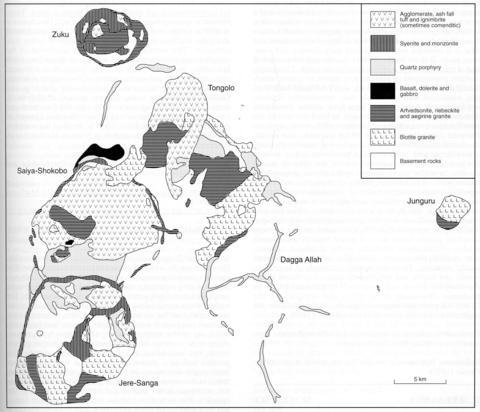stripes
This complex is contiguous with Jere-Sanga (No. 122-00-022) to the south, a ring-dyke of which cuts rocks of the southern part of Saiya-Shokobo, and Tongolo (No. 122-00-023) to the northeast. The Shokobo Hills form the southern end of the complex and the Saiya Hills a steep, serrated ridge in the north. The complex lies within an elliptical fracture of about 18 km diameter subsidence on which has preserved the earliest volcanic rocks as a broad strip lying east-west across the centre of the complex. Later, further subsidence in the north preserved a group of peralkaline ignimbrites (Turner, 1979) which are referred to by Buchanan et al. (1971) as the Saiya aegirine-arfvedsonite porphyry. Later activity involved intrusion of a range of granites and syenites. The earliest recognised member of the complex is a large arcuate dyke of dolerite on the northern margin, with smaller dykes and sheets elsewhere; it contains a little biotite. The early volcanic rocks in the central area are essentially rhyolites, mainly ignimbrites, with a thickness of about 600 m now exposed. These are commonly quartz- and feldspar-phyric and aegirine and a sodic amphibole are generally present while fluorite is common and andradite occurs at one locality. The more northerly outcropping ignimbrites are also feldspar- and quartz-phyric with a matrix of the same minerals, arfvedsonite and a little aegirine. The southern part of the complex is dominated by hedenbergite-arfvedsonite-quartz porphyry which forms a dome-shaped intrusion and in places large roof pendants and rafts; it is crowded with xenoliths of early rhyolite and basement rocks. It is cut by the Limoro syenite ring-dyke which is part of the Jere-Sanga complex lying to the south. The syenite contains phenocrysts of perthite in a matrix of quartz, which constitutes up to 15% of the rock, alkali feldspar, hedenbergite, sometimes with amphibole rims, arfvedsonite, ilmenite and calcite. A discontinuous ring-dyke almost completely encircles the complex and is thought to mark the line of the main fracture controlling emplacement of the early rhyolites. The total circumference is over 50 km and some, but not all, discontinuities have been caused by later intrusions. The rock is porphyritic with phenocrysts of perthite in a fine- to very fine-grained matrix in narrow parts of the dyke to microgranitic in wider parts, quartz, generally in granophyric texture with alkali feldspar, blades of riebeckite and a little aegirine. A substantial intrusion of arfvedsonite granite cuts the central area of volcanics and there is a similarly sized biotite granite, the Rishi granite, extending across the ring-dyke to the northeast, which establishes contact with the adjacent Tongolo complex (No. 122-00-023). The biotite granite contains abundant greisen zones up to a metre wide in which occur patches of cassiterite, sphalerite as the dominant sulphide, with chalcopyrite, azurite, malachite, helvite and danalite locally abundant. There are smaller intrusions of hastingsite syenite and biotite and arfvedsonite granites scattered across the complex which are described in greatest detail by Buchanan (Buchanan et al., 1971) and depicted on the 1:1,000,000 geological map accompanying that publication. Six analyses of rocks are given in MacLeod et al. (1971).
BUCHANAN, M.S., MACLEOD, W.N., TURNER, D.C., BERRIDGE, N.G. and BLACK, R. 1971. The geology of the Jos Plateau. Volume 2, Younger granite complexes. Bulletin, Geological Survey of Nigeria, 32: 1-159.MACLEOD, W.N., TURNER, D.C. and WRIGHT, E.P. 1971. The geology of the Jos Plateau. Volume 1, General geology. Bulletin, Geological Survey of Nigeria, 32: 1-110.TURNER, D.C. 1979. Nigeria: the northern ring complexes. Geological map, scale 1:250,000. St Andrews University Younger Granite Research Group.

